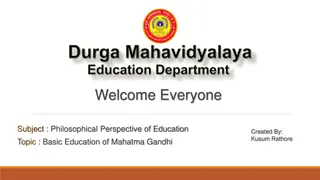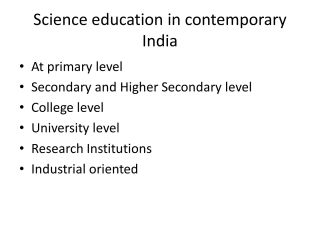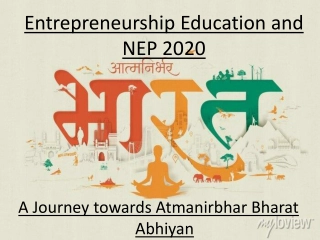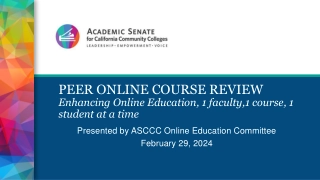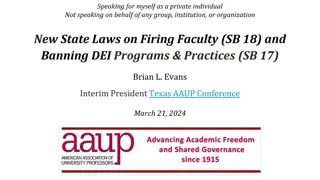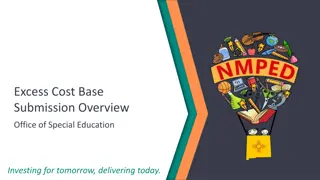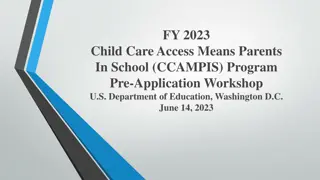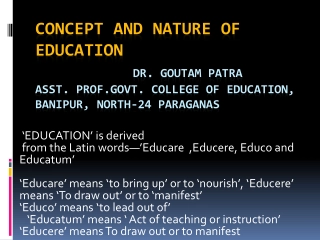AI in Education
Exploring the potential of AI in education, this presentation covers topics such as student performance analysis, test post-mortems, and strategies for positive reinforcement and improvement. It delves into methods like regular self-testing, collaborating with peers, utilizing resources effectively, and preparing mindfully for assessments. The content emphasizes reflective practices, seeking help when needed, and leveraging technology for enhanced learning outcomes.
Download Presentation
Please find below an Image/Link to download the presentation.
The content on the website is provided AS IS for your information and personal use only. It may not be sold, licensed, or shared on other websites without obtaining consent from the author. Download presentation by click this link. If you encounter any issues during the download, it is possible that the publisher has removed the file from their server.
Presentation Transcript
AI in Education Our new frontier
Student Positive Reinforcement Areas of Improvement You made a significant effort to overcome your areas of weakness before the test. You also did regular self- testing to identify your strengths and weaknesses. 1 Do all practice SACs and checkpoints and complete more practice questions to be confident. Seek more resources and use them effectively. Collaborate more with peers and actively participate in discussions. 2 You made extensive use of CheckPoints. You made a significant effort to overcome your areas of weakness before the test. You completed regular self-testing to identify your strengths and weaknesses. You are active in collaborating with others for the purpose of study. 3 Keep reflecting on your performance and analyse your mistakes. Do more extensive reflection. Collaborate more effectively with your peers and attempt difficult questions from past SACs or checkpoints. Self-assess to understand and rectify limitations in your knowledge. 4 You are active in collaborating with others for the purpose of study. Collaborate more with others and complete more practice tests, review notes, and complete chapter questions. Create notes on how to tackle specific types of questions/scenarios. 5 You made extensive use of CheckPoints. Prepare well ahead of time and do more checkpoints earlier. Ask more questions and prepare earlier. 6 You actively look for opportunities to work with others outside of class. Seek additional physics resources and ask questions when unsure about the content. Complete the checkpoint questions at a steady pace as you learn the coursework. 7 You made extensive use of CheckPoints. 8 You completed some self-testing to identify areas of strengths and weaknesses. Make more notes and complete all checkpoints questions. 9 You actively look for opportunities to work with others outside of class. Create a more extensive reference sheet as preparation. Complete all checkpoint questions. Collaborate more effectively with others and create a comprehensive reference sheet that includes the steps to answering questions. Start checkpoints earlier and review mistakes made in questions before the SAC. 10 You made a significant effort to understand your mistakes. Keep your mistakes book updated and seek help from your peers and teachers. Do more practice SAC questions under timed conditions and practice getting used to using your calculator under fast conditions. You made a significant effort to overcome your areas of weakness before the test. You made extensive use of CheckPoints. You are active in collaborating with others for the purpose of study. 11 You made a significant effort to overcome your areas of weakness before the test. You actively look for opportunities to work with others outside of class. Make notes and refer to them often to retain much of your knowledge. Do more practice questions and revision materials. 12 Utilize checkpoints as a valuable tool to assist with harder questions. Make a time plan to spread your workload over a longer period of time. 13 You actively look for opportunities to work with others outside of class. Prepare for specific types of questions and ask friends and teachers whenever you find something challenging. Prepare for any twists or modifications SACs might put on specific questions. Prepare for SACs at least 2 weeks prior to it. 14 You made a significant effort to understand your mistakes.
Proactively Laying the Foundations AI is coming at us very quickly much faster than traditional curriculum sources can adapt Our students are using AI to assist them with their work already Our students need counsel and direction regarding the ethical and social implications of utilizing AI, both in their education and in their future careers and personal lives. It may possibly become one of the most significant elements of the digital divide
Using AI in the Classroom Intelligent.com s recent survey of college students, released barely two months after the launch of ChatGPT. Fully 30 percent of college students said they were already turning in some ChatGPT- penned assignments; one in thirty said ChatGPT was already doing all their written work. These are the earliest of adopters it s a safe bet their ranks will grow dramatically before long. Will ChatGPT Be A Blow To Learning, Or A Boon? We'll Decide. (forbes.com) What are our Learning Objectives around AI? What knowledge about AI do we want the students to acquire? How can students develop key skills around AI that will benefit their learning in the long-term? How might AI effect the development of a young person s digital citizenship?
What might ethical AI student use look like? Writing Assistance: AI-powered writing assistants can help students generate ideas and improve the quality of their writing. Students can use such tools to refine their writing skills and produce more polished work. Research Assistance: AI-powered search engines can help students find relevant and credible sources for their research. Students can use these tools to save time and improve the quality of their work. Writing Feedback: AI-powered writing assistants can provide feedback on writing assignments, making suggestions for improvements and help students to produce more polished and refined work.
What might ethical AI student use look like? Test Preparation: AI-powered test preparation tools can help students prepare for exams by identifying areas where they need to focus their study efforts and providing practice questions and exercises. Completing Data Analysis: AI-powered data analysis tools can help students analyze complex data sets and identify patterns and trends. This can help students develop their analytical skills. Automated Summarization: AI-powered summarization tools can help students quickly and accurately summarize long texts and articles. This can help students better understand complex ideas and identify key themes and arguments.
Teaching Objectives It s about the Joy of Learning( ) Learning needs be even less about achieving an arbitrary benchmark, and more about personal development Critical Thinking and Problem Solving Students will need to gain an even broader and deeper understanding of what constitutes quality information (credible sources, AI training data, etc.) Students should be able to identify the potential benefits and limitations of using AI in the learning process, such as personalized learning experiences, increased efficiency, and the need for human oversight and decision-making. Understanding the benefits and limitations of AI
Teaching Objectives Students will need to be able to identify ethical concerns related to the use of AI during the learning process Understanding the ethical implications of AI and their data privacy and security issues algorithmic bias potential misuse of data Applying AI to real-world situations Students should be able to apply their understanding of AI to real-world situations, such as analyzing data sets, developing predictive models, or using virtual assistants
What do we want our students to know about AI? It is ALL in the prompt How to design prompts effectively When you use it, use it well How to design templates for effective prompts Examples of well written prompts How can you tell the difference between a useful AI and a less effective AI? There are differences between the AI models Who makes the model? What are their motivations? Who are their backers? This is a rapidlyevolving landscape
How can students develop key AI skills? Students will need to actively engage with the AI LLMs to improve their skills in using the models. This requires the ability to ask questions, get feedback, and adjust their learning strategies based on their progress. Active Engagement with AI Students will need to reflect on their learning experiences with AI LLMs and be able to identify when and how interactions have gone right ; or wrong , Opportunities for Reflection Students should be able to ask questions freely about the use of AI and how it might be used to assist their undertaking of different tasks, to assist them in learning material across different topics and help them prepare for assessments. They need to see it used effectively across disciplines
How might AI effect the development of a young person s digital citizenship? There is a risk that our young people may become too reliant on AI powered tools, losing some elements of their critical thinking and problem-solving capacity. There is also an opportunity to use the emergence of AI tools as a teaching opportunity. Dependence on Technology? AI can be both a tool for enhancing and limiting students cultural exposure. Will our young people become more susceptible to biases or will AI broaden their perspectives? Cultural Exposure? AI LLMs can provide learning experiences that simulate human interaction, but there is a risk that students may not receive the full benefits of human interaction in the learning process. They may not have the opportunity to reflect on real-world situations or engage in authentic conversations. A further decrease in human interaction?
Why Addressing AI is a Professional Imperative for Educators We are not just faculty members and teachers of a discipline This has the capacity to affect wellbeing There is now no avoiding AI
Faculty Based Responses to AI How is AI likely to affect your teaching with regard to: Assessment Design Setting up Revision Material Developing research tasks Developing writing tasks Classroom dynamics Student discussion and questioning Student help seeking Student note-taking Assessing student wellbeing
Student Based Responses to AI What might students think when it comes to the availability of AI LLMs and our teaching? Undertaking Assessments Preparing for Assessments Completing Research tasks Completing Writing tasks Participating in classroom discussion and questioning Help seeking Note-taking Wellbeing









